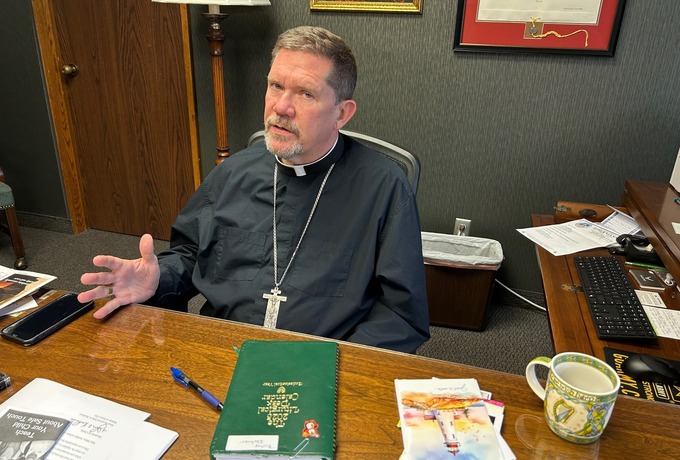Bishop Keehner reflects on his first USCCB gathering
-
 June 26, 2025By RENEE WEBB
June 26, 2025By RENEE WEBB
Content and Design Coordinator
Merely six weeks after his episcopal ordination, Bishop John E. Keehner had the opportunity to meet with his brother bishops on a large scale during a week-long retreat held June 16-20 in San Diego.
“Every year the U.S. Conference of Catholic Bishops meet twice,” explained the bishop.
In most years, the June meeting of the U.S. bishops is to discuss business. Every third year the spring assembly is a retreat for bishops to pray, converse and strengthen one another in their ministries.
The November fall plenary gatherings held in Baltimore are formal business meetings with updates and conversations on important topics, voting and so forth.
“I’ve been told those can be very tense meetings because of the seriousness of the issues they are dealing with,” said Bishop Keehner, who noted this recent gathering focused on the fraternity and prayer.
With that in mind, several seasoned bishops commented to Bishop Keehner that he was fortunate to have the retreat as his first USCCB gathering.
The speaker/retreat leader was Archbishop J. Michael Miller, who recently retired after serving as the Archbishop of Vancouver, Canada, from 2009 to until earlier this year. He previously served as a professor and academic administrator at the University of St. Thomas in Houston. In addition, he worked at the Vatican for the Secretariat of State, Congregation for Catholic Education and the Pontifical Work of Priestly Vocations.
“His topic was the role of the bishop as seen through the eyes of the last three popes. We heard a lot about the writings of John Paul II, specifically his apostolic exhortation following the synod on bishops and the document is called Pastores Gregis,” said Bishop Keehner. “It just so happens, that is what I focused on for my pre-ordination retreat.”
The bishop noted prior to the pre-ordination retreat he asked a friend for an idea on reading material that would be helpful. Pastores Gregis was suggested as it offers doctrinal and pastoral principles to guide bishops in their role as shepherds of the Lord’s flock.
As the retreat leader delved into the document, Bishop Keehner said he was happy he read and prayed over contents of the exhortation in late March.
The retreat leader also included references to comments by popes made during such things as ad limina visits, Chrism Mass homilies and other special gatherings.
“He was so up to date that there were even a few references from Pope Leo XIV from an ad limina visit the week before,” said Bishop Keehner.
Content included things that bishops should be doing and not be doing.
“How do we care for one another, how do we for our priests, how do we care for our people,” he said. “For me it was very insightful. I found it very helpful.”
Bishop Keehner also found the small group discussions to be helpful.
“They weren’t necessarily based on the talks, it just gave us an opportunity to meet with a group of bishops we might not have been able to meet otherwise,” he said. “We looked at some basic questions about our vocation, our initial call to the priesthood, where we find strength in our ministries as bishops.”
In his first group, Bishop Keehner was the only new bishop. There was a retired bishop, a cardinal, couple auxiliary bishops and an archbishop. His second group contained several long-time bishops and even a bishop-elect. The mix of experiences provided great insight.
“Listening to their stories of faith and hope, I found that helpful,” he said, adding that the opportunity to pray with his brother bishops was another benefit of the retreat. “We prayed together several times a day – morning prayer, Mass, holy hour with adoration and benediction each day.” Plus, there were opportunities for confession.
Because the location along the bay and weather was so beautiful, they had most meals outside.
“And there was the opportunity to sit with different people at each meal,” said Bishop Keehner, who noted that for one meal he sat with friends he studied with in Rome and another was with Iowa bishops. “It was a nice opportunity in a very casual atmosphere to meet bishops from throughout the country.”
As a whole, he found the experience to be very prayerful, fraternal and edifying.
One of the main focuses of the gathering that he prayed about and walked away with is that the bishop is called to be a person a hope.
“Sometimes you are doing that in very difficult situations, but you always do so from the vantage point of hope,” said Bishop Keehner. Reflecting on what it means to live in hope, he added, that “it doesn’t mean that everything will be okay, but in the midst of your suffering Christ will be present.”
In early September, Bishop Keehner will go to Rome for “bishops’ school.” During this week-long process, he and other new bishops will meet with the various dicasteries - the congregations or departments – that do the administrative work of the Holy See to learn how those offices can be of service to the diocesan churches and their expectations of the diocesan churches.
A letter from Cardinal Robert F. Prevost who is now Pope Leo, stated it would provide opportunities for collegiality among new bishops from various parts of the world and to meet the Holy Father. At the time, the cardinal who wrote the letter wasn’t the pope.
The fall plenary meeting of bishops is set for Nov. 10 to 14.
